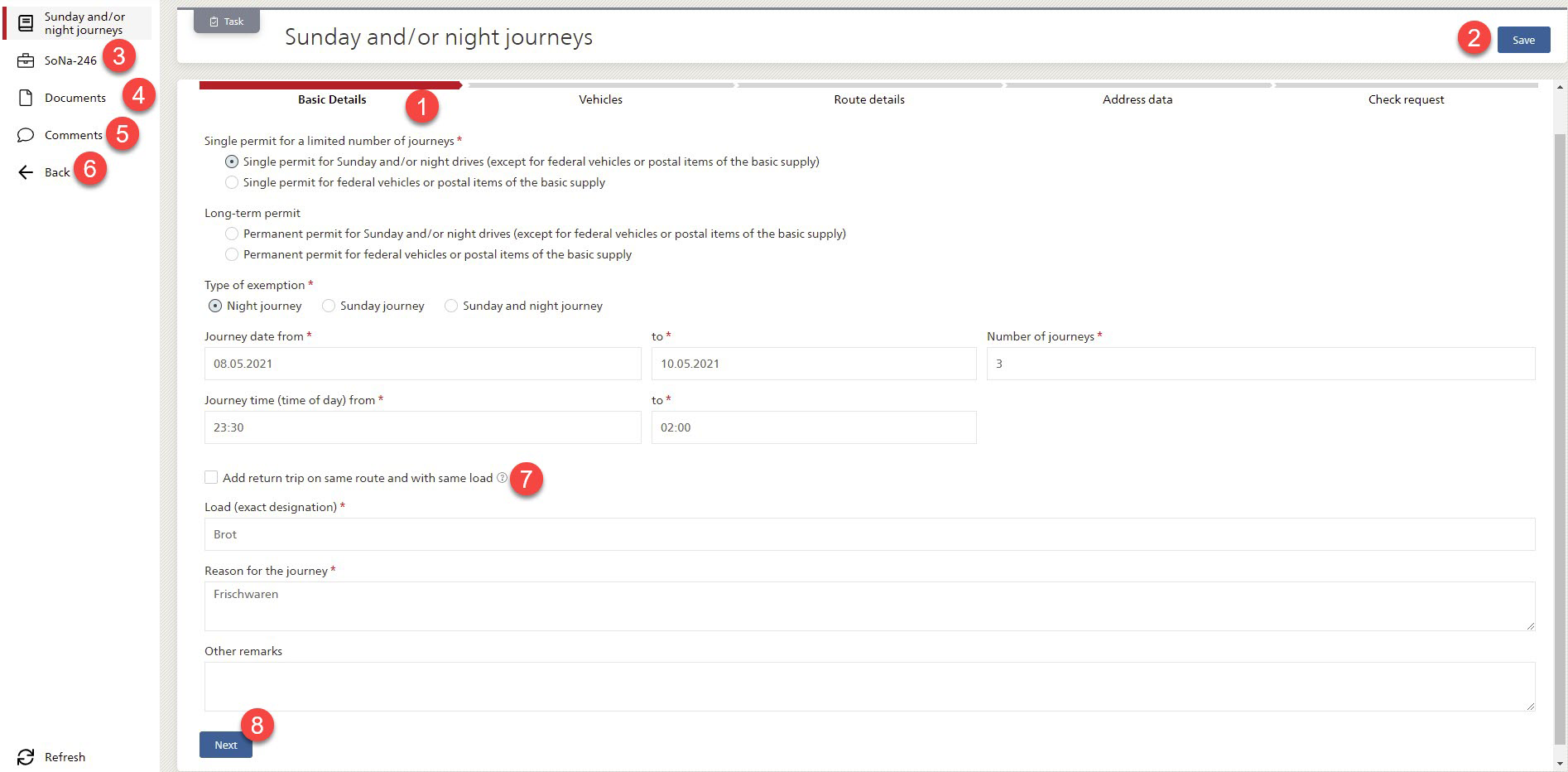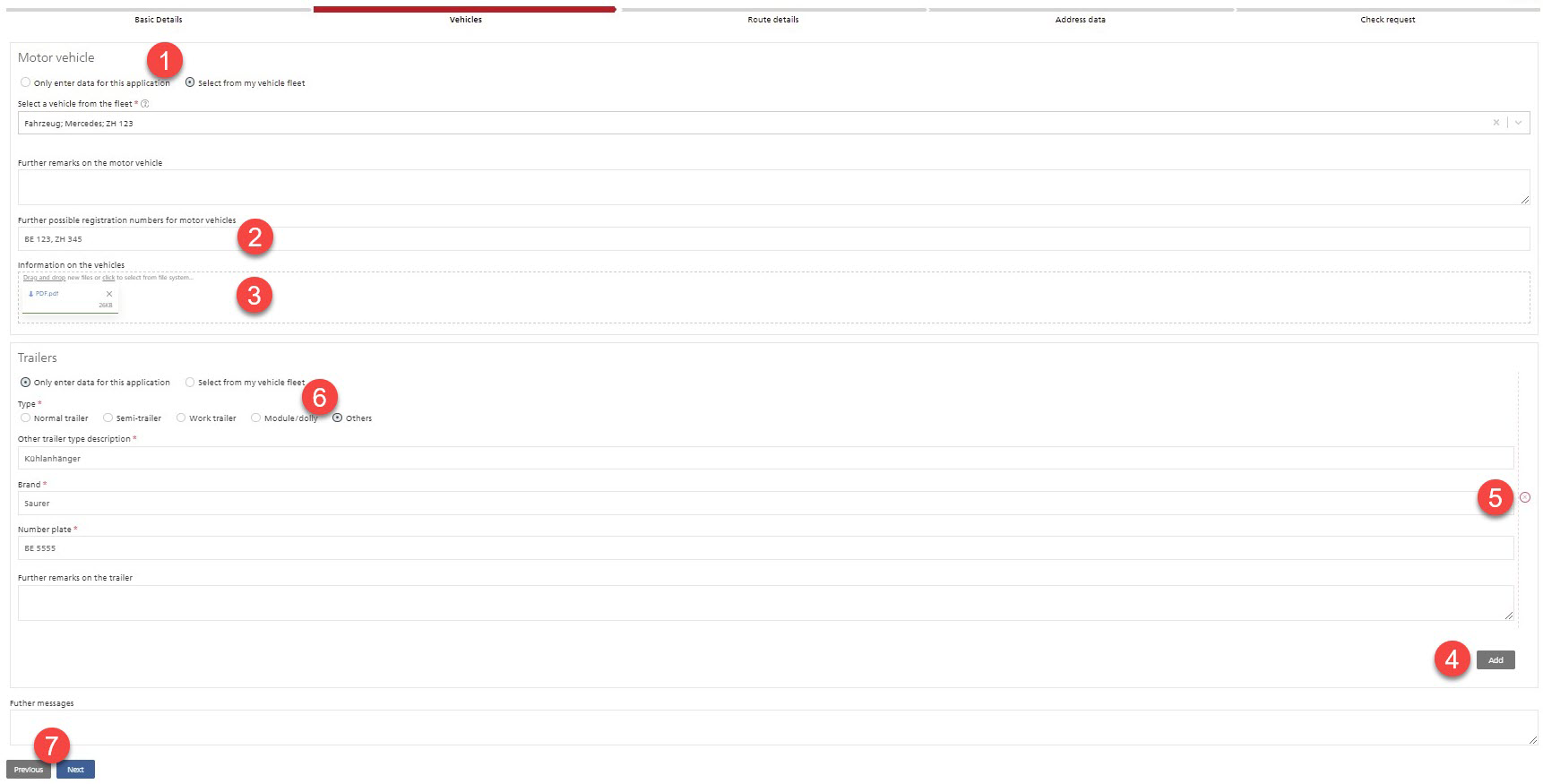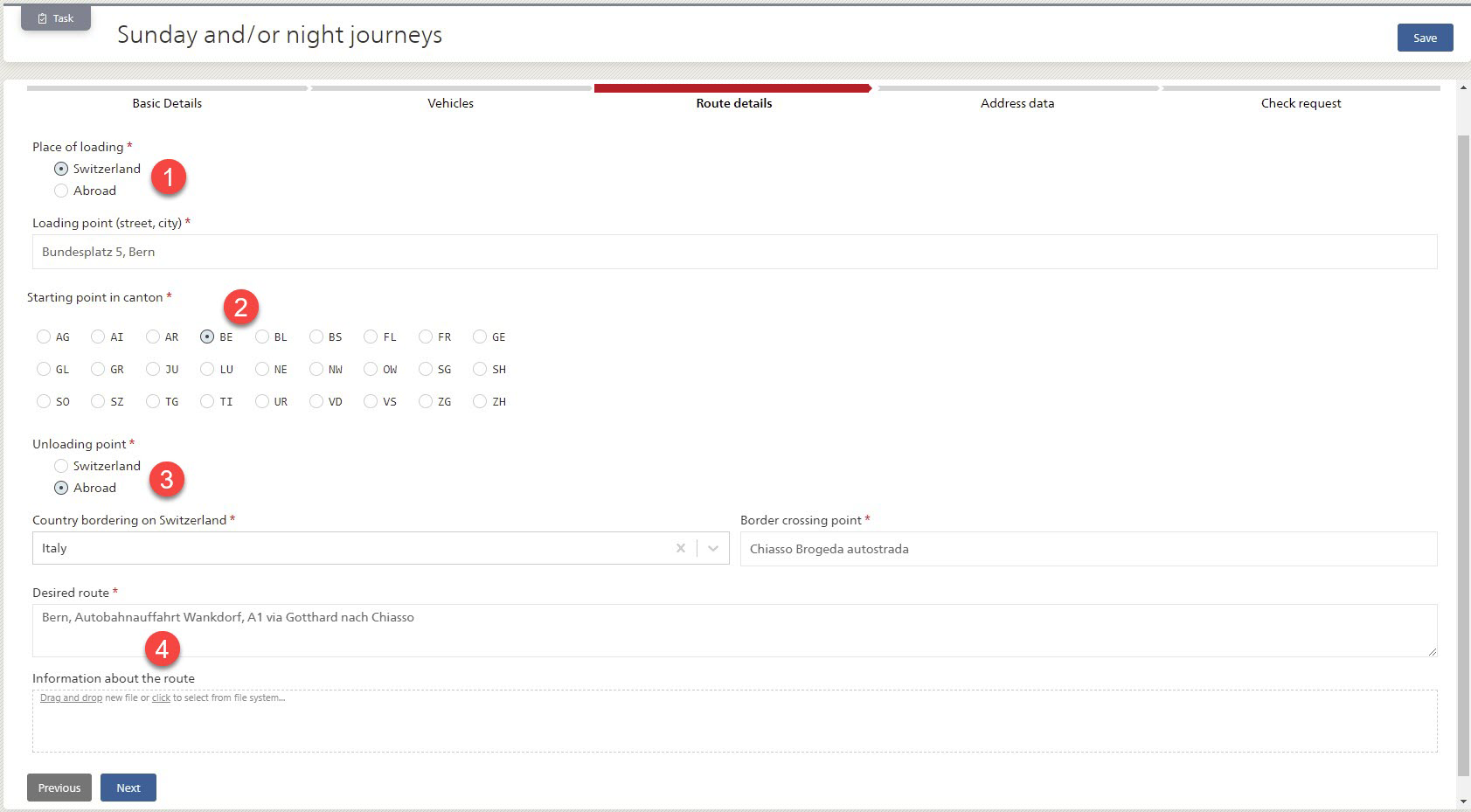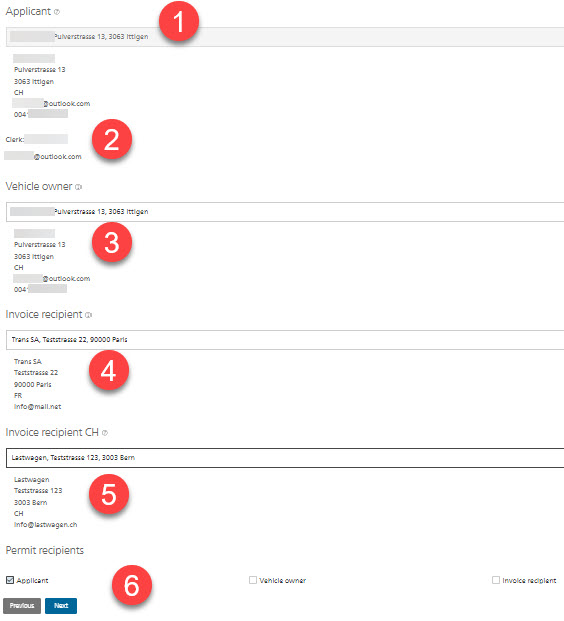Submit an application to a cantonal approval authority or to FEDRO for a Sunday and/or night journey (SuNi) for vehicles with a permissible total weight of more than 3.5 t, for articulated motor vehicles with a permissible total towing weight of more than 5 t, or for vehicles having a trailer with a permissible total weight of more than 3.5 t. You can find further information at Sonderbewilligungen - Sonntags- und Nachtfahrten.
Creating a new application

To create a so-called SuNi application, select the menu item “Create new application” (1) and complete the page that opens:
Select the application type “Sunday/night journey SuNi” (2) and enter a description (3). You can freely choose the designation. It will help you to find the application again later. Under special details (4), you can, for example, enter the reference number of your order. This indication will help you to classify the application and does not have to be completed. Then choose the language in which the permit should be created (5). As the permit may contain instructions to the carrier, it is best to have it issued in the carrier’s language. This is independent of the language in which you complete the application. You can only press the “Create a new application” button (6) once you have correctly completed all the fields marked with a red asterisk *.
The dossier
When you press this button, a so-called dossier will be created and you will be shown the application-filing step:

A dossier is a collection of all the data, tasks and documents created in connection with your application. The first task is to enter the application. This is done in several steps which you are guided through; the first is entering the basic data (1). If you are not yet able - or don’t want - to complete and submit the entire application, you can save it temporarily (2). You can also leave the screen for entering your data at any time. By clicking on the dossier number, here SuNi-246 (3), you can access the detailed screen of the dossier. Later on, you can see here the status of the work of the approval authorities. But at present it appears you have not yet submitted your dossier, so no tasks will be found there yet for the authorities. You can also navigate to the document management function of the application (4), enter a comment for FEDRO (5) or go back to the dossier list and to the main menu (6) if, for example, you would like to enter an address or a vehicle before submitting the application.
If you exit the form without pressing Save, your entries made in the current step will be lost. But entries made in previous steps will remain saved.
SuNi basic data
To create the application, please now complete the details for the “Basic data” step. You can apply for a single-journey permit or a long-term permit. Unless the permits are to be valid for federal vehicles or transports of postal consignments under the universal service, the application will be processed by the approval authority of the starting canton, which you selected in the route details. Applications for federal vehicles or transports of postal consignments under the universal service go to FEDRO.
The fields that you have to complete are interdependent. For example, for a night journey, you must also enter a time, whereas for a daytime Sunday journey, the date is sufficient. In the case of a single-journey permit, you also have the option of applying for the return journey on the same route and with the same load in the same application. If you wish to do so, select the corresponding checkbox and complete the fields that are now displayed. You cannot apply for a return journey with a long-term permit.
If a field is marked with a small question mark, you will find more information on its meaning if you hover over it with the mouse (7).
Here too, you have to complete all fields marked with a red asterisk and a red text below the field will tell you when your entry does not comply with the specifications. Only when all the necessary fields have been completed correctly will the “Next” button appear (8). If you think you have completed everything correctly but the button still doesn’t appear, it’s best to navigate through the entire form with the tabulator, from field to field. In this way, any further error messages, if applicable, will be displayed.
With “Next” you will reach the next step “Vehicles”.
SuNi vehicles

Here you can first choose whether you would like to enter your vehicle data only once or use a vehicle from your fleet (1). With the first option, you need to enter various details about the vehicle you are using. If you often file SuNi applications and use the same vehicles over and over again, you can enter them in your vehicle management function before creating the application and simply select them here with the second option, so that the data is incorporated in the application. In both cases, you also have the option of indicating further possible number plates (2) and attaching a document containing further information on the vehicles (e.g. a list of all the vehicles in a convoy) (3). Various document formats are permitted. If you try to attach an unauthorized format or a document that is too large, an error message to this effect will be displayed and you will have to remove the document again. If it has been attached successfully, this will be indicated by a green bar.
If you are driving with a trailer, you can show the fields required for this by clicking on “Add” in the “Trailers” section (4). You can also add several trailers. If fields are shown for trailers, here again you must correctly complete all fields marked with an asterisk. If you don’t need the additional trailer after all, you can remove it again with the small X on the right (5). Any entries in these fields will be deleted as a result.
For trailers too, you can choose whether you wish to enter the data only for this application or use data from your trailer management function.
As soon as you’ve completed all the data correctly, the “Next” button appears again. As you are now on step 2 of the application, there’s also the possibility of going back to the previous step to check or adapt it (2). But first save what you have entered, otherwise that data will be deleted!
SuNi route details
By pressing “Next”, you get to the route details.

First, choose whether the journey requiring a permit is to begin in Switzerland or abroad (1). If the journey starts in Switzerland, please enter at least the street and the town/city. If the journey starts abroad, select the country from which the vehicle will enter Switzerland and then enter the border crossing point. The same principle also applies to the place of unloading (3).
If it is not an application for federal vehicles or transports of postal consignments under the universal service (i.e. for which FEDRO is responsible), the responsible canton is the one where the vehicle is registered or where the journey subject to a permit is to begin. For journeys from abroad to Switzerland, the canton where the vehicle enters the country is responsible. Please select the responsible canton under Starting canton or Border canton, as applicable (2). This choice does not appear if FEDRO is responsible for the permit.
Finally, enter the desired route (4), attach documents here with further information on the route if you wish (e.g. a tour plan) and finally continue to the “Address data” step.
SuNi address data
In this step, the address data of the applicant, carrier and invoice recipient must be indicated.

As the applicant (1), the main address of your group account is automatically selected, as you are responsible for this application. You can’t choose another address here. Your name and e-mail address (2) are also displayed here. So it can be seen which member of the group account created the application.
As vehicle owner (3) and invoice recipient (4), the main address of your account is also completed first. But here you can select any other address from your address management function. Since some cantons require an invoicing address in Switzerland, you must enter such an address under “Invoice recipient CH” (5) if the actual invoice recipient has a foreign address.
Finally, you can indicate to whom the permit should be sent (6). Once it has been issued, it will be sent by e-mail to the selected parties. Confirmation of the application and the associated application document, on the other hand, will always be sent to the applicant’s e-mail addresses after submission (to you personally and to the main address) AND to the invoice recipient in order to inform him/her/it of the application.
Press “Next” here as well to check and submit the application.
Checking and submitting a SuNi application

In the last step “Check application”, you can use the “Download preview” link (1) to generate a PDF version of the application so as to check your entries. To submit the application, you must tick the checkbox (2) to confirm that you have read and accepted the special terms and conditions. Only then will the button “Submit for approval” (3) appear. As soon as you press this button, the application will be submitted to FEDRO and you will receive a PDF version of it as confirmation by e-mail. The dossier overview will now be displayed:

Here you will find the so-called dossier number “SuNi-246” (1), which is a unique identification of your dossier. By means of this number, you can find your dossier in the dossier list. The number will also be mentioned in every communication about the dossier. The detailed screen will display the current status of the dossier (2), including all open tasks (3) that now have to be carried out. In this case, the approval authority of the canton of Bern must examine the dossier and issue the permit. You will find all open and already-completed tasks on the right, including your own - preparation of the application (4) - marked as completed. You will also find here the navigation options explained above (5). And if your plans should change, you have the option of cancelling your applications (6), i.e. withdrawing them as invalid. This is possible free of charge with an application filed to FEDRO, but only as long as the permit has not yet been issued. In applications to a cantonal approval authority, you should clarify possible financial consequences in advance with the authority concerned.
What happens next?
The dossier will now be assessed by the approval authority of the competent canton or by FEDRO. If any further details are required from you, the authority will get in touch with you via the comment function. You will be informed by e-mail, as you will if the application cannot be approved. As soon as the permit is issued, it will be sent by e-mail to the addresses you selected as permit recipient in the “Address data” step. Finally, the invoice is issued, but outside of the SA SP.
You can find your dossier in the dossier list at any time and select it to review the current status. Here you will also find the application document and later the permit document, as well as all other documents submitted (under “Documents” in section 5) or any additional queries and answers from you to the authority or vice versa (under “Comments” in section 5).
Error
If the button to the next step is not displayed, it means you have not yet completed all the data correctly. This applies to the buttons “Create a new application”, “Next” and “Submit for approval”. This may also happen if, for example, you have already completed the “Basic data” step at an earlier point in time and have continued to complete the application, but in the meantime the journey data you entered are in the past.
In such a case, check that you have completed all the fields marked with a red asterisk * and that no field is still marked with a red error message. Should you still not discover the error, select the first field of the form and navigate through the form with the tabulator key until an error or the button is displayed.
